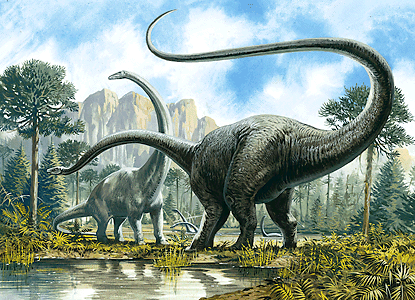First Sauropod Dinosaur Fossil Discovered in Antarctica
Dec. 27, 2011
The discovery of the first sauropod fossil ever found in Antarctica has been announced by a team of scientists from Argentina. Sauropods, a common kind of planet-eating dinosaur, hold the record as the largest land animals to inhabit Earth. The fossil, which has been dated to about 70 million years old, is only a single vertebra–too small for scientists to determine the exact species. (Vertebrae are the bones that make up the spine.) But the scientists determined that the bone belonged to a sauropod. Scientists have found only a few dinosaur fossils in Antarctica because of the continent’s harsh conditions making searching difficult, though they believe many kinds of dinosaurs lived there.
Some sauropods may have grown as long as 130 feet (40 meters) and weighed as much as 85 tons (77 metric tons). They are among the most familiar dinosaurs, with long necks and tails. There were many kinds of sauropods, including such well-known species as Brachiosaurus and Apatosaurus. Sauropods fossils had previously been discovered on all other continents.

Supersaurus was one of the largest dinosaurs that ever lived. It measured from 100 to 130 feet (30 to 40 meters) long, stood about 27 feet (8.2 meters) tall at the hips, and may have weighed more than 40 tons (36 metric tons). The animal's slender neck may have stretched as long as 40 feet (12 meters). Its huge, whiplike tail probably extended about 50 feet (15 meters). World Book illustration by John Francis, Bernard Thornton Artists
The newly discovered dinosaur lived during the Cretaceous Period, which lasted from about 145 million to 65 million years ago. During this time, Antarctica was not covered by a thick ice sheet, as it is now. Earth’s climate was much warmer in the Cretaceous Period than it is today. As a result, Antarctica was able to support plant life, which provided food for large dinosaurs. Also, Antarctica was still connected to what are now Australia and South America in a supercontinent called Pangaea. The fossil was discovered on Ross Island, in West Antarctica.
Additional World Book articles:


